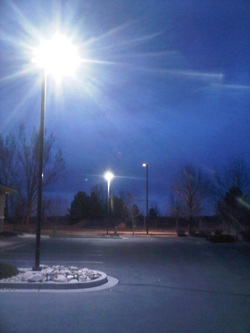
Most everyone is familiar with the traditional incandescent light bulb and equally familiar with the ways that have historically been used to describe the light emitted from these bulbs. For example, if I say, "this room should have a 100 watt light bulb in it," you likely know immediately what I am referring to and have a general sense that this would be a relatively bright reading light.
However, one of the challenges created because of the dramatically increased efficiency of LED lighting is that using a traditional power measurement such as 100 watts does not offer any precise information about how bright the light drawing this much power would be. For example, our company, Leading Edge Designs, carries a 75 watt LED light fixture that is bright enough to be used as a street light - a far cry from a 100w incandescent light!
Therefore, one of the challenges faced by the lighting industry as a whole is how to consistently measure (and describe) brightness across different technologies, especially when they can be drastically different in the magnitude of intensity. Currently, one of the common ways to describe brightness that can be applied to both traditional and new technologies is to use the term "Lumen." Wikipedia defines a Lumen as "the International System of Units derived unit of luminous flux, a measure of the total 'amount' of visible light emitted by a source." (Luminous Flux is further defined here...)
This certainly seems like a reasonable unit to use, since it measures the total "amount" of visible light, and in many ways it is very useful. However, a challenge is created because Lumens actually measure the total amount of visible light emitted by a source without regard to the direction this light is emitted. Because of this, it does not accurately reflect the amount of light that actually reaches the eye of an observer. Some reasons for this are uniform across technologies, such as the amount of dust and other particles in the air, so these don't impact a meaningful discussion of how "bright" a light is, because they tend to have a relatively consistent impact on different lighting technologies.
However, there are some reasons that the total brightness of a light source doesn't reach an observer's eye that are different because of the technologies involved. The ones I'd like to focus on today are directional light and reflected light intensity.
Traditional (incandescent, high intensity discharge, etc.) lights emit light in all directions. In contrast, LED lighting is directional, meaning that all of the light energy is emitted in the direction the light is pointed (in whatever beam pattern it is designed to produce). For example, most Leading Edge Design lights are designed to emit a 120º beam pattern, so all light is directed within that 120º pattern. Traditional lights emit light in all 360º, meaning that essentially 50% or more of the light emitted is directed away from the intended illumination. Often times, light that is initially emitted in the wrong direction is reflected back generally toward the intended illumination point, however, this light looses brightness along the way, especially since some of the reflected light is reflected back into the original light source or is refracted along the way.
Another common way to measure light intensity that is often used in regulations such as OSHA (Occupational Safety and Health Administration) standards is the unit of measure foot-candle. I'll discuss the difference between this and a Lumen in a future post. In the meantime, you can learn more about the latest in LED light fixtures at our website, www.LED-ltd.us. Please post a comment or question on the blog, and we'll get back to you as soon as possible.

 RSS Feed
RSS Feed
